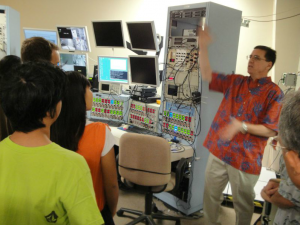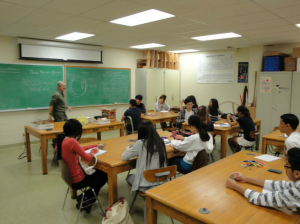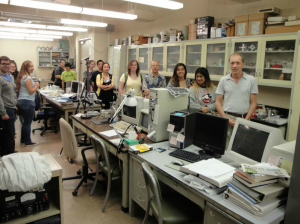Department of Physics and Astronomy research to shine at open house
University of Hawaiʻi at MānoaAssociate Researcher, Physics and Astronomy
Talia Ogliore, (808) 956-4531
Public Information Officer, Vice Chancellor for Research

The annual Physics and Astronomy Open House features live demonstrations and research presentations.
The annual Department of Physics and Astronomy Open House will be held on Saturday, November 23, 2013, from 8:30 a.m. to noon on the UH Manoa campus. The event is free and open to the public. Local high school teachers and students have also been invited to attend.
Ten sites in Watanabe Hall and one in Krauss Annex will feature physics and astronomy research and applications of physics described by University faculty and students.
The open house includes a variety of live demonstrations that illustrate physics principles in mechanics, optics, and electricity and magnetism (E&M). The hands-on demos will allow attendees to experiment with angular momentum and center of gravity; operate a hover craft; check out polarized light effects; and experience the power of electromagnets, among other fun activities.
Classroom topics will include:
- Large Hadron Collider and the Higgs Bozon. The 2013 Nobel Prize in Physics honored the theory that predicted the Higgs boson. Learn about the experiment at CERN that confirmed this fundamental particle.
- Nanophysics: Examine the world through ultra-high resolution microscopes, including a state-of-the-art Atomic Force Microscope and a scanning-tunneling electron microscope, both of which produce stunning images of atomic surface structures.
- Free Electron Laser: See the laser invented by UH Mānoa’s John Madey, which has a wide variety of fundamental and applied research uses, from ultra-sensitive LIDAR and remote sensing, to medical research applications for hard- and soft-tissue studies.
- Alpha Magnetic Spectrometer Experiment – in Space: Learn how scientists are using the unique environment of space to advance knowledge of the universe by searching for antimatter and dark matter, and by measuring cosmic rays.
Other sessions focus on a variety of physics topics, including particle detection, neutrinos and dark matter. A full agenda is available in the News & Events section of the Physics and Astronomy website (www.phys.hawaii.edu).
Activities begin at 8:30 a.m., with an overview of the events in the HIG Auditorium; groups will then follow a schedule until 11:00 a.m. The public is welcome to join one of the groups before 11:00 a.m. and/or to visit sites informally from 11:00 a.m. until noon.
For more information, visit: http://www.phys.hawaii.edu/


